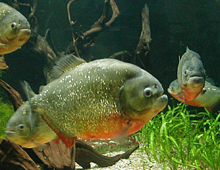Description: Red-bellied piranhas get their name from their characteristic red belly. The chin and caudal fin are also red. The rest of the body is gray-brown with flecks of gold and silver. Black spots are found behind the gills. Body colors and tints vary in regions, age and gender, with the eyes in adults ranging from clear to reddish; some females have darker red bellies than males. They have a powerful jaw that contains a single row of tightly packed triangular-shaped, interlocking teeth with needle-sharp points. The teeth are capable of slicing through bone.
Size: They can reach lengths up to 15 inches (38 cm) but are typically six to eight inches (15-20 cm) and weigh up to three pounds (1.4 kg). Red-bellied piranhas can weigh seven or more pounds (3.2 kg).
Behavior: Red-bellied piranhas spend most of their time hunting for food. These communal feeders hunt in packs or shoals of up to 30 or more individuals, hiding until they attack their prey. The presence of blood in the water turns the feeding into a frenzy. Piranhas are prey of crocodilians, larger fish, fish-eating birds and large mammals such as Jaguars. They are also a staple food item of many people.
Diet: As opportunistic feeders, they eat fish, aquatic invertebrates, crustaceans, insects, algae and aquatic plants. They will also attack mammals and birds that swim or stand in the water.
Senses: They have an advanced sense of smell, which helps them locate prey. Red-bellied piranhas
can sense any unusual vibrations in the water around them by using their lateral line system – a special line of sensors down the sides of their bodies that picks up changes in water pressure, currents and movement.
Communication: Communication is exhibited acoustically and through aggressive behaviors such as biting, chasing and fighting. They produce a drumming sound by causing vibrations with their muscles that echos through their swim bladder.
Reproduction: After the completion of a courtship display in which mates swim in circles, females deposit several thousand eggs in bowl-shaped nests that are built by the males near water plants. The eggs stick to the plants and the male swims by fertilizing them. The male guards and tends the eggs and is very territorial during this time. The fertilized eggs may hatch in as few as two or three days, depending on temperature of the water. After hatching, the young piranhas stay on the bottom hiding among the plants. Once they are large enough to defend themselves they leave their hiding place.
Habitat/range: This species inhabits freshwater rivers throughout South America: Argentina, Brazil, Bolivia, Colombia, Ecuador, Guyana, Paraguay, Peru and Venezuela, preferring areas with dense vegetation.
Status: Red-bellied piranhas are common and have not been classified by the IUCN Red List.



